Rick Just's Blog, page 22
June 1, 2024
The Hemingway Cats
Give me one word that you associate with Ernest Hemingway. Writer? Outdoorsman? Fishing? Hunting?
How about, cats? If you look hard enough you can find a picture of Hemingway with a hunting dog, but you'll find many pictures of him with his cats or just pictures of his cats. Here are a few I thought you might enjoy.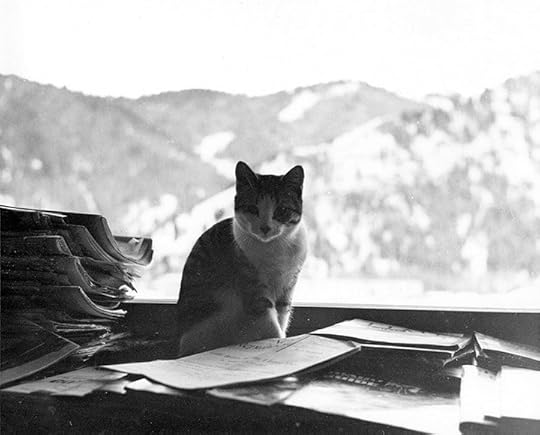 Ernest Hemingway’s cat Big Boy Peterson sits among papers in front of a window with a view of Bald Mountain at Hemingway’s home in Ketchum, Idaho, undated. Ernest Hemingway Photographs Collection. John F. Kennedy Presidential Library and Museum, Boston.
Ernest Hemingway’s cat Big Boy Peterson sits among papers in front of a window with a view of Bald Mountain at Hemingway’s home in Ketchum, Idaho, undated. Ernest Hemingway Photographs Collection. John F. Kennedy Presidential Library and Museum, Boston.  Ernest Hemingway and his cat, Boise, outside his home, Finca Vigia, in Cuba. Ernest Hemingway Photographs Collection, John F. Kennedy Presidential Library and Museum, Boston.
Ernest Hemingway and his cat, Boise, outside his home, Finca Vigia, in Cuba. Ernest Hemingway Photographs Collection, John F. Kennedy Presidential Library and Museum, Boston. 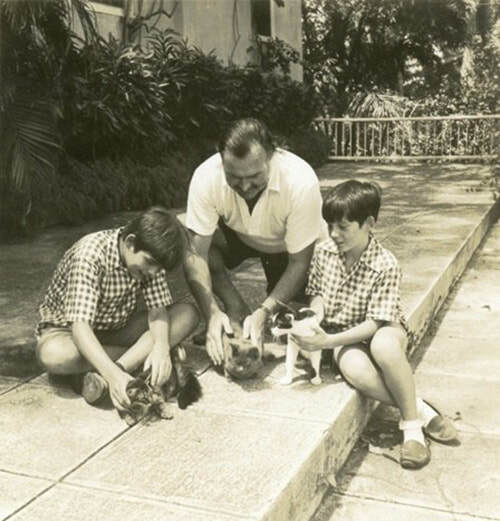 Patrick “Mouse” Hemingway, Ernest Hemingway, and Gregory “Gigi” Hemingway with three cats (Good Will, Princessa, and Boise) at Finca Vigia, Cuba, November 1946. Ernest Hemingway Photograph Collection, John F. Kennedy Presidential Library.
Patrick “Mouse” Hemingway, Ernest Hemingway, and Gregory “Gigi” Hemingway with three cats (Good Will, Princessa, and Boise) at Finca Vigia, Cuba, November 1946. Ernest Hemingway Photograph Collection, John F. Kennedy Presidential Library. 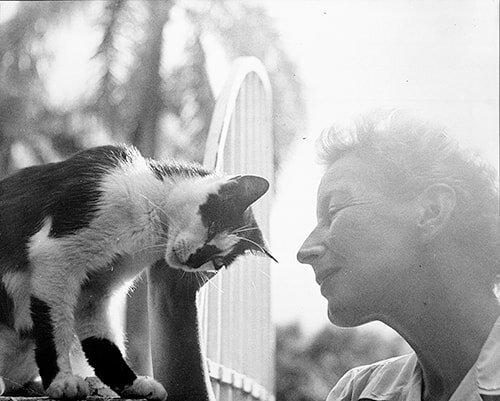 Mary Hemingway with cat, Boise. Finca Vigia, San Francisco de Paula, Cuba. Ernest Hemingway Photograph Collection, John F. Kennedy Presidential Library.
Mary Hemingway with cat, Boise. Finca Vigia, San Francisco de Paula, Cuba. Ernest Hemingway Photograph Collection, John F. Kennedy Presidential Library. 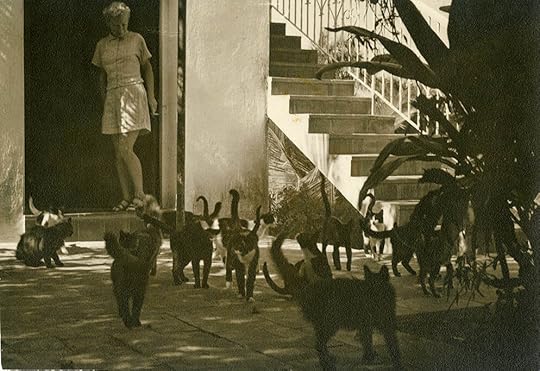 A whole lot of cats with Mary Welsh Hemingway in the doorway. Ernest Hemingway Photograph Collection, John F. Kennedy Presidential Library.
A whole lot of cats with Mary Welsh Hemingway in the doorway. Ernest Hemingway Photograph Collection, John F. Kennedy Presidential Library.
How about, cats? If you look hard enough you can find a picture of Hemingway with a hunting dog, but you'll find many pictures of him with his cats or just pictures of his cats. Here are a few I thought you might enjoy.
 Ernest Hemingway’s cat Big Boy Peterson sits among papers in front of a window with a view of Bald Mountain at Hemingway’s home in Ketchum, Idaho, undated. Ernest Hemingway Photographs Collection. John F. Kennedy Presidential Library and Museum, Boston.
Ernest Hemingway’s cat Big Boy Peterson sits among papers in front of a window with a view of Bald Mountain at Hemingway’s home in Ketchum, Idaho, undated. Ernest Hemingway Photographs Collection. John F. Kennedy Presidential Library and Museum, Boston.  Ernest Hemingway and his cat, Boise, outside his home, Finca Vigia, in Cuba. Ernest Hemingway Photographs Collection, John F. Kennedy Presidential Library and Museum, Boston.
Ernest Hemingway and his cat, Boise, outside his home, Finca Vigia, in Cuba. Ernest Hemingway Photographs Collection, John F. Kennedy Presidential Library and Museum, Boston.  Patrick “Mouse” Hemingway, Ernest Hemingway, and Gregory “Gigi” Hemingway with three cats (Good Will, Princessa, and Boise) at Finca Vigia, Cuba, November 1946. Ernest Hemingway Photograph Collection, John F. Kennedy Presidential Library.
Patrick “Mouse” Hemingway, Ernest Hemingway, and Gregory “Gigi” Hemingway with three cats (Good Will, Princessa, and Boise) at Finca Vigia, Cuba, November 1946. Ernest Hemingway Photograph Collection, John F. Kennedy Presidential Library.  Mary Hemingway with cat, Boise. Finca Vigia, San Francisco de Paula, Cuba. Ernest Hemingway Photograph Collection, John F. Kennedy Presidential Library.
Mary Hemingway with cat, Boise. Finca Vigia, San Francisco de Paula, Cuba. Ernest Hemingway Photograph Collection, John F. Kennedy Presidential Library.  A whole lot of cats with Mary Welsh Hemingway in the doorway. Ernest Hemingway Photograph Collection, John F. Kennedy Presidential Library.
A whole lot of cats with Mary Welsh Hemingway in the doorway. Ernest Hemingway Photograph Collection, John F. Kennedy Presidential Library.
Published on June 01, 2024 04:00
May 31, 2024
Falks Store, Idaho
Falk’s Store was a place. That’s not an astonishing pronouncement, but hold on. I don’t mean it was a store, so thus a place. I mean it was a store that became a town’s name: Falk’s Store.
Vardis Fisher’s 1938 Idaho Encyclopedia lists it as a ghost town in Payette County. I’ve seen it listed as “Falk Store,” and also under the town name “Falks.”
Nathan Falk, one of the brothers who owned what became known as Falk’s Idaho Department Store, or Falk’s ID, in Boise, had a store in Payette County that snagged the local post office for the community in 1872. Falk’s Store, which would lose its possessive apostrophe under naming conventions today, was located on the Payette River between Emmett and Fruitland.
Falk’s Store was also a station for the Utah, Idaho, and Oregon Stage Line, giving it a revolving customer base. In addition to its namesake store the town had a ferry, a hotel, a saloon, a blacksmith shop, and a boot and saddle shop.
Nathan Falk’s store is said to have prospered in Falk’s Store, Idaho for several years. A 1922 fire marked the end of town. Nothing remains of it today, although a nearby bridge carries the name Falk's Bridge.
 The Falk’s Store in Falk’s Store, circa 1892. Courtesy of the Idaho State Historical Society Digital Collection
The Falk’s Store in Falk’s Store, circa 1892. Courtesy of the Idaho State Historical Society Digital Collection
 An ad for the stores in Boise and along the Payette, 1874.
An ad for the stores in Boise and along the Payette, 1874.
Vardis Fisher’s 1938 Idaho Encyclopedia lists it as a ghost town in Payette County. I’ve seen it listed as “Falk Store,” and also under the town name “Falks.”
Nathan Falk, one of the brothers who owned what became known as Falk’s Idaho Department Store, or Falk’s ID, in Boise, had a store in Payette County that snagged the local post office for the community in 1872. Falk’s Store, which would lose its possessive apostrophe under naming conventions today, was located on the Payette River between Emmett and Fruitland.
Falk’s Store was also a station for the Utah, Idaho, and Oregon Stage Line, giving it a revolving customer base. In addition to its namesake store the town had a ferry, a hotel, a saloon, a blacksmith shop, and a boot and saddle shop.
Nathan Falk’s store is said to have prospered in Falk’s Store, Idaho for several years. A 1922 fire marked the end of town. Nothing remains of it today, although a nearby bridge carries the name Falk's Bridge.
 The Falk’s Store in Falk’s Store, circa 1892. Courtesy of the Idaho State Historical Society Digital Collection
The Falk’s Store in Falk’s Store, circa 1892. Courtesy of the Idaho State Historical Society Digital Collection An ad for the stores in Boise and along the Payette, 1874.
An ad for the stores in Boise and along the Payette, 1874.
Published on May 31, 2024 04:00
May 30, 2024
"Big Ed" Sanders
“Big Ed” Sanders led a meteoric life. Born in 1930 in the Watts neighborhood of Los Angeles, he was a standout in track and field and football at Jordan High School. Compton Junior College recruited the 6-foot-4, 220-pound high school senior to play football. It was at Compton that he learned to box.
Hayes Edward Sanders was at the 1950 National Junior College Boxing Championships in Ogden, Utah when Idaho State College boxing coach Dubby Holt spotted him.
Holt, for whom Holt Arena at Idaho State University is named, led a boxing program that was getting national attention. “Big Ed,” who had won the NCAA Junior Championship in 1949 and 1950, jumped at the chance to box for ISC.
A young man by the name of Jake LaRue picked Sanders up at the train station. “Big Ed” would soon marry Jake’s sister, Mary, who worked in the ISC athletic department. Things happened fast in Sander’s life.
“Big Ed” knocked out the Pacific Coast Heavyweight Champion in his first fight for the college. He continued for a little over a year, setting a record by never losing a bout in a college dual meet.
In 1951 the Korean War was the big fight the country was most interested in. Sanders got drafted. Holt advised him to enlist so he could join the U.S. Navy Boxing Team. He did so and proceeded to beat the Navy Heavyweight Champion and burn through a series of Golden Gloves tournaments.
In 1952, “Big Ed” Sanders qualified for the summer Olympic games. His first three opponents were no match for him. The fight for the gold was with Ingemar Johansson who would later become the World Heavyweight Champion. Johansson was less trouble for Sanders than the previous fights. The Swedish boxer was disqualified in the second round for largely avoiding contact with Sanders.
“Big Ed” Sanders became the first African American Olympic Heavyweight champion. The City of Los Angeles named a day in his honor. The media loved the humble big man, constantly asking for interviews. He turned pro in 1953. It was the logical next step for such a gifted fighter, and with a new son at home, he needed the money. But boxing is not a gentle sport. On December 12, 1954 Sanders fought the New England Heavyweight Champion, Willie James. In round 11 James threw a flurry of punches that knocked Sanders down. He would not get up again.
Sanders died at age 24, leaving behind his wife Mary and their 17-month-old son, Russel. He was inducted into the Idaho State College Athletic Hall of Fame. In 2012 Sanders was also inducted into the Compton Community College Athletics Hall of Fame.
Thanks to Idaho State Journal writer Jason Enes for his story on Sanders in 2012, from which much of the information for this post was gleaned.
 Sanders (right) against Jack Scheberies during the American Olympic Boxing Championships in June 1952
Sanders (right) against Jack Scheberies during the American Olympic Boxing Championships in June 1952
Hayes Edward Sanders was at the 1950 National Junior College Boxing Championships in Ogden, Utah when Idaho State College boxing coach Dubby Holt spotted him.
Holt, for whom Holt Arena at Idaho State University is named, led a boxing program that was getting national attention. “Big Ed,” who had won the NCAA Junior Championship in 1949 and 1950, jumped at the chance to box for ISC.
A young man by the name of Jake LaRue picked Sanders up at the train station. “Big Ed” would soon marry Jake’s sister, Mary, who worked in the ISC athletic department. Things happened fast in Sander’s life.
“Big Ed” knocked out the Pacific Coast Heavyweight Champion in his first fight for the college. He continued for a little over a year, setting a record by never losing a bout in a college dual meet.
In 1951 the Korean War was the big fight the country was most interested in. Sanders got drafted. Holt advised him to enlist so he could join the U.S. Navy Boxing Team. He did so and proceeded to beat the Navy Heavyweight Champion and burn through a series of Golden Gloves tournaments.
In 1952, “Big Ed” Sanders qualified for the summer Olympic games. His first three opponents were no match for him. The fight for the gold was with Ingemar Johansson who would later become the World Heavyweight Champion. Johansson was less trouble for Sanders than the previous fights. The Swedish boxer was disqualified in the second round for largely avoiding contact with Sanders.
“Big Ed” Sanders became the first African American Olympic Heavyweight champion. The City of Los Angeles named a day in his honor. The media loved the humble big man, constantly asking for interviews. He turned pro in 1953. It was the logical next step for such a gifted fighter, and with a new son at home, he needed the money. But boxing is not a gentle sport. On December 12, 1954 Sanders fought the New England Heavyweight Champion, Willie James. In round 11 James threw a flurry of punches that knocked Sanders down. He would not get up again.
Sanders died at age 24, leaving behind his wife Mary and their 17-month-old son, Russel. He was inducted into the Idaho State College Athletic Hall of Fame. In 2012 Sanders was also inducted into the Compton Community College Athletics Hall of Fame.
Thanks to Idaho State Journal writer Jason Enes for his story on Sanders in 2012, from which much of the information for this post was gleaned.
 Sanders (right) against Jack Scheberies during the American Olympic Boxing Championships in June 1952
Sanders (right) against Jack Scheberies during the American Olympic Boxing Championships in June 1952
Published on May 30, 2024 04:00
May 29, 2024
All Faces West
Thanks to Tom Trusky, who was the top sleuth of Idaho movies, I’ve had an interest in them for several years. I recently ran across an oblique mention of one I’d never heard of called All Faces West.
The mention of the movie included a note of regret that it was never shown because it had been filmed as a silent movie just when talkies were coming out. I decided to see what I could find out about it.
First, it was a movie with at least four titles. That’s not especially unusual because a movie often goes into production with a working title that changes before release. This one had two working titles,
The Exodus and The Exodus of the New World. It was meant to tell the struggle of the Mormons as they moved West to Utah. It premiered in Salt Lake City in 1929 under the title All Faces West to good local reviews.
When it was put out for general release as Call of the Rockies in 1931, there had been some changes. The movie had lost the original tie to the story of the Mormons, and sound had been added. Sort of. There was some narrative at the beginning of the film and at the end, otherwise the familiar dialogue cards were inserted to move the story along. Oh, and they dubbed in some additional sounds such as barking dogs and whinnying horses to thrill movie goers.
Those changes were probably the result of someone trying to cobble together a flick that would make some money. The production company had gone bankrupt after spending about $250,000 on the project. Someone bought the rights to the film for $10,000.
Most of the movie was shot in Utah, but several scenes were filmed near Heise Hot Springs and along the Snake River near Twin Falls.
So, not purely an Idaho movie but certainly one that should be included in the history of Idaho filmmaking.
 Marie Prevost, one of the starts of All Faces West, later released as Call of the Rockies.
Marie Prevost, one of the starts of All Faces West, later released as Call of the Rockies.
She appeared in 121 silent and sound films during her 20-year career. Sadly, Alcoholism took her life at the age of 40 in 1937. Her death was one of the catalysts for the creation of the Motion Picture & Television Country House and Hospital.
The mention of the movie included a note of regret that it was never shown because it had been filmed as a silent movie just when talkies were coming out. I decided to see what I could find out about it.
First, it was a movie with at least four titles. That’s not especially unusual because a movie often goes into production with a working title that changes before release. This one had two working titles,
The Exodus and The Exodus of the New World. It was meant to tell the struggle of the Mormons as they moved West to Utah. It premiered in Salt Lake City in 1929 under the title All Faces West to good local reviews.
When it was put out for general release as Call of the Rockies in 1931, there had been some changes. The movie had lost the original tie to the story of the Mormons, and sound had been added. Sort of. There was some narrative at the beginning of the film and at the end, otherwise the familiar dialogue cards were inserted to move the story along. Oh, and they dubbed in some additional sounds such as barking dogs and whinnying horses to thrill movie goers.
Those changes were probably the result of someone trying to cobble together a flick that would make some money. The production company had gone bankrupt after spending about $250,000 on the project. Someone bought the rights to the film for $10,000.
Most of the movie was shot in Utah, but several scenes were filmed near Heise Hot Springs and along the Snake River near Twin Falls.
So, not purely an Idaho movie but certainly one that should be included in the history of Idaho filmmaking.
 Marie Prevost, one of the starts of All Faces West, later released as Call of the Rockies.
Marie Prevost, one of the starts of All Faces West, later released as Call of the Rockies.She appeared in 121 silent and sound films during her 20-year career. Sadly, Alcoholism took her life at the age of 40 in 1937. Her death was one of the catalysts for the creation of the Motion Picture & Television Country House and Hospital.
Published on May 29, 2024 04:00
May 28, 2024
The 1966 Political Crashes
1966 was going to be a pivotal election year no matter what. The Idaho Legislature had passed the 3-cent sales tax and Governor Robert E. Smylie had signed the bill. State Senator Don Samuelson, Sandpoint, was challenging the governor in the Republican primary based at least in part on Smylie’s support of the sales tax. The Democratic primary pitted a former Idaho state senator, Charles Herndon from Salmon, against Idaho State Senator Cecil Andrus, from Orofino.
Sales tax was a divisive issue, almost as divisive as the Viet Nam War was becoming. But airplanes would change the course of that year’s election as much as issues.
First, a leading contender for the Republican nomination for Congress from Idaho’s First Congressional District crashed his airplane near Osborne. John N. Mattmiller, who had run unsuccessfully for the seat in 1964, was piloting his four-place Piper Comanche over North Idaho’s Silver Valley when the crash happened. An experienced pilot, Mattmiller had survived a crash five years earlier that had broken both legs.
According to witnesses, the Comanche dropped out of the overcast into the narrow valley, apparently looking for a place to land. Mattmiller narrowly missed the KWAL radio tower in Osborne. The plane seemed to be headed for a landing on U.S. 10, about five miles from his destination at the Smelterville airport. Mattmiller pulled up when he saw a tanker truck on the highway, and banked the plane around, perhaps for another landing attempt. That’s when he struck a powerline, bringing the plane down hard. Mattmiller, and a passenger both died instantly.
Mattmiller’s untimely death opened up the primary for a young state senator named Jim McClure. McClure was elected to Congress and served in the House of Representatives until 1973 when he was elected to the U.S. Senate. He served there until his retirement in 1991.
In the primary for governor, Samuelson surprised Smylie, defeating the long-serving governor soundly. Herndon sneaked by Cecil Andrus by about 1,300 votes setting up a general election bout with Samuelson.
Then came the second crash. On September 14, 1966, Herndon was in Pocatello looking for a flight to Coeur d’Alene where he had an afternoon speaking engagement. Nothing commercial was flying because the Pocatello and Idaho Falls airports were socked in with fog.
Herndon made a highway dash for Twin Falls where he chartered an airplane. Two men from Oklahoma City who had business in North Idaho shared the charter with Herndon.
Herndon and the pilot, Bill Bir of Twin Falls, were in the front seats of the Piper Apache. Oddly, when the plane came out of the clouds and plowed into a forested hillside ten miles west of Stanley, the Oklahoma passengers in back were killed instantly. Herndon and the pilot were badly injured. The pilot was airlifted from the crash site to a Sun Valley hospital. He survived. Charles Herndon died before he could be taken from the crash site.
The runner-up in the Democratic primary was named to replace Herndon on the ticket. That was the first time Cecil D. Andrus faced Don Samuelson. Samuelson won the first match, becoming Idaho’s 25th governor. Four years later, Andrus would become the 26th governor of Idaho, defeating Samuelson. He would eventually win four elections to that post and become Secretary of the Interior in President Jimmy Carter’s cabinet.

Sales tax was a divisive issue, almost as divisive as the Viet Nam War was becoming. But airplanes would change the course of that year’s election as much as issues.
First, a leading contender for the Republican nomination for Congress from Idaho’s First Congressional District crashed his airplane near Osborne. John N. Mattmiller, who had run unsuccessfully for the seat in 1964, was piloting his four-place Piper Comanche over North Idaho’s Silver Valley when the crash happened. An experienced pilot, Mattmiller had survived a crash five years earlier that had broken both legs.
According to witnesses, the Comanche dropped out of the overcast into the narrow valley, apparently looking for a place to land. Mattmiller narrowly missed the KWAL radio tower in Osborne. The plane seemed to be headed for a landing on U.S. 10, about five miles from his destination at the Smelterville airport. Mattmiller pulled up when he saw a tanker truck on the highway, and banked the plane around, perhaps for another landing attempt. That’s when he struck a powerline, bringing the plane down hard. Mattmiller, and a passenger both died instantly.
Mattmiller’s untimely death opened up the primary for a young state senator named Jim McClure. McClure was elected to Congress and served in the House of Representatives until 1973 when he was elected to the U.S. Senate. He served there until his retirement in 1991.
In the primary for governor, Samuelson surprised Smylie, defeating the long-serving governor soundly. Herndon sneaked by Cecil Andrus by about 1,300 votes setting up a general election bout with Samuelson.
Then came the second crash. On September 14, 1966, Herndon was in Pocatello looking for a flight to Coeur d’Alene where he had an afternoon speaking engagement. Nothing commercial was flying because the Pocatello and Idaho Falls airports were socked in with fog.
Herndon made a highway dash for Twin Falls where he chartered an airplane. Two men from Oklahoma City who had business in North Idaho shared the charter with Herndon.
Herndon and the pilot, Bill Bir of Twin Falls, were in the front seats of the Piper Apache. Oddly, when the plane came out of the clouds and plowed into a forested hillside ten miles west of Stanley, the Oklahoma passengers in back were killed instantly. Herndon and the pilot were badly injured. The pilot was airlifted from the crash site to a Sun Valley hospital. He survived. Charles Herndon died before he could be taken from the crash site.
The runner-up in the Democratic primary was named to replace Herndon on the ticket. That was the first time Cecil D. Andrus faced Don Samuelson. Samuelson won the first match, becoming Idaho’s 25th governor. Four years later, Andrus would become the 26th governor of Idaho, defeating Samuelson. He would eventually win four elections to that post and become Secretary of the Interior in President Jimmy Carter’s cabinet.

Published on May 28, 2024 04:00
May 27, 2024
Idaho, the Song
When you hear the word Idaho, the first thing you think of is jazz, right? Right?
Okay, maybe not. But there is a pretty great song called “Idaho” that is a fairly well-known jazz piece. It was written by Jesse Stone who, as far as I know, had no connection to Idaho.
“Idaho” was originally recorded by Alvino Rey and his orchestra in 1941. The next year, Benny Goodman had a version that hit number 4 on the pop charts. Here’s a link to that one. You’ll probably have to endure a few seconds of commercial before you get to it. Oh, and don’t expect the singing to start right away. Guy Lombardo sold 4 million copies of his version.
The song is a snappy little number. Even so, I was surprised to learn that Stone was also the writer behind the decidedly rock, “Shake, Rattle, and Roll.”

Okay, maybe not. But there is a pretty great song called “Idaho” that is a fairly well-known jazz piece. It was written by Jesse Stone who, as far as I know, had no connection to Idaho.
“Idaho” was originally recorded by Alvino Rey and his orchestra in 1941. The next year, Benny Goodman had a version that hit number 4 on the pop charts. Here’s a link to that one. You’ll probably have to endure a few seconds of commercial before you get to it. Oh, and don’t expect the singing to start right away. Guy Lombardo sold 4 million copies of his version.
The song is a snappy little number. Even so, I was surprised to learn that Stone was also the writer behind the decidedly rock, “Shake, Rattle, and Roll.”

Published on May 27, 2024 04:00
May 26, 2024
Verified Reception
This is an unused “verified reception” stamp from KSEI radio in Pocatello. During the 1920s and early 1930s it became a fad to collect these stamps from stations far away. Some collectors had stamp books in which they kept their prizes.
Listeners who heard a weak signal from a far-away station sent that station a card telling the details of what they heard, such as the subject of a newscast, what a commercial said, or what song was playing at the time. The stations would send back a card with a stamp on it verifying that the description matched their programing at that moment.
Some of the companies producing the stamps also sold them unused to collectors. This is one of those unused stamps, which I am donating to the History of Idaho Broadcasting Foundation for their museum in Caldwell, which is housed in the old KFXD studios there. It isn’t yet open to the public, but we’ll keep you posted.
The reason this odd hobby existed is that atmospheric conditions at night make it possible for AM signals to travel great distances. The AM waves bounce off the ionosphere when darkness falls. If the receiver is also in the dark, the signals can be heard halfway across the globe.
Most AM stations don’t bother printing up stamps anymore, but the hobby still exists among shortwave enthusiasts. It’s called DXing. The D is for distance and the X is for unknown. There are magazines about it and online chat groups. DXers get all the relevant information to prove they heard the station, then send the station an email for confirmation.
Back in the late 60s, when I was working at KBLI in Blackfoot, I remember getting a DX card from someone in Japan who had heard the sign-off recording just as the sun was going down, the perfect time to catch a signal from a daytime only station.

Listeners who heard a weak signal from a far-away station sent that station a card telling the details of what they heard, such as the subject of a newscast, what a commercial said, or what song was playing at the time. The stations would send back a card with a stamp on it verifying that the description matched their programing at that moment.
Some of the companies producing the stamps also sold them unused to collectors. This is one of those unused stamps, which I am donating to the History of Idaho Broadcasting Foundation for their museum in Caldwell, which is housed in the old KFXD studios there. It isn’t yet open to the public, but we’ll keep you posted.
The reason this odd hobby existed is that atmospheric conditions at night make it possible for AM signals to travel great distances. The AM waves bounce off the ionosphere when darkness falls. If the receiver is also in the dark, the signals can be heard halfway across the globe.
Most AM stations don’t bother printing up stamps anymore, but the hobby still exists among shortwave enthusiasts. It’s called DXing. The D is for distance and the X is for unknown. There are magazines about it and online chat groups. DXers get all the relevant information to prove they heard the station, then send the station an email for confirmation.
Back in the late 60s, when I was working at KBLI in Blackfoot, I remember getting a DX card from someone in Japan who had heard the sign-off recording just as the sun was going down, the perfect time to catch a signal from a daytime only station.

Published on May 26, 2024 04:00
May 25, 2024
The Idaho State Fair Song
I grew up in Eastern Idaho where the Idaho State Fair is a big deal. In my formative years I heard the song “Idaho State Fair” enough for it to become an ear worm. It occurs to me that faithful readers of this blog might not all have had the chance to enjoy it. So, here’s a link to the song.
You probably didn’t hear this on top 40 stations in 1952—excluding KBLI of course—when it was recorded by Vaughn Monroe. That’s because it was the B side of the 45. The A side was “Lady Love,” which you likely didn’t hear either. As a public service, I provide you with a link so you can determine for yourself why this might not have been a big hit. You’re welcome.
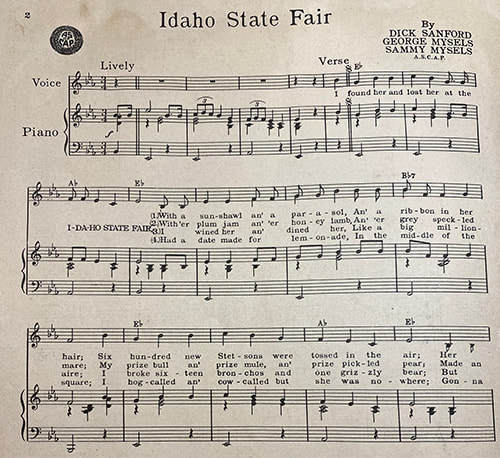
You probably didn’t hear this on top 40 stations in 1952—excluding KBLI of course—when it was recorded by Vaughn Monroe. That’s because it was the B side of the 45. The A side was “Lady Love,” which you likely didn’t hear either. As a public service, I provide you with a link so you can determine for yourself why this might not have been a big hit. You’re welcome.

Published on May 25, 2024 04:00
May 23, 2024
Souvenir Signatures
A governor’s signature on a bill can be one of the most important things they do. That same signature on a proclamation can have some level of importance, or it might be largely ceremonial. Today’s post is about the signatures that you may not have known that governors do.
There are collectors of gubernatorial signatures lurking around out there. I was one of them for a while. I collected a few from sitting governors when I came across them while working for the State of Idaho. Those were mostly proclamations and minor correspondence. Since I had a few of those, I decided to see if I could collect gubernatorial signatures from past governors.
It’s easy to start a hobby like that these days thanks to eBay. You can create a search bot that alerts you whenever the words governor, Idaho, and signature or autograph pop up. I collected a few signatures that were created during the course of business, such as a canceled check from George Shoup, Idaho’s last territorial governor and first state governor. Mostly, though, the signatures existed because someone wrote to the sitting governor and requested one.
Most governors answered requests like that by signing a blank card or even the outside of an envelope that was returned to the requestor. Here are a few samples.
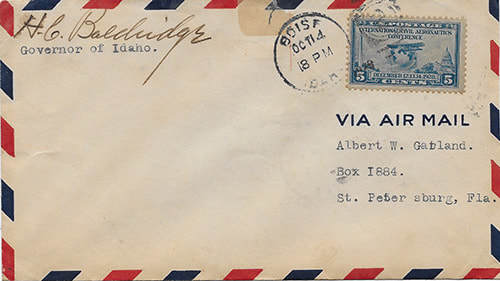 Governor Henry Clarence Baldridge simply signed the front of an official envelope.
Governor Henry Clarence Baldridge simply signed the front of an official envelope.
 Governor C.A. Robbins created a souvenir for those requesting his autograph. Above is a special reply in the shape of a potato with room for the signature on the back. On the inside there were three scenes of Idaho.
Governor C.A. Robbins created a souvenir for those requesting his autograph. Above is a special reply in the shape of a potato with room for the signature on the back. On the inside there were three scenes of Idaho.
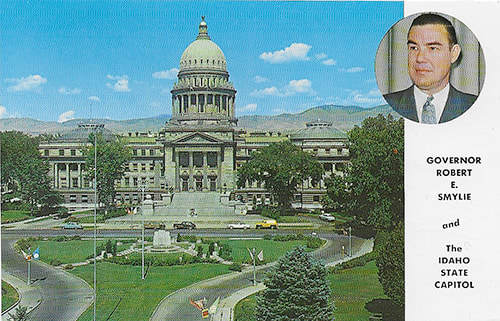 Governor Robert E. Smylie sent a postcard with his photo and a picture of the statehouse.
Governor Robert E. Smylie sent a postcard with his photo and a picture of the statehouse.
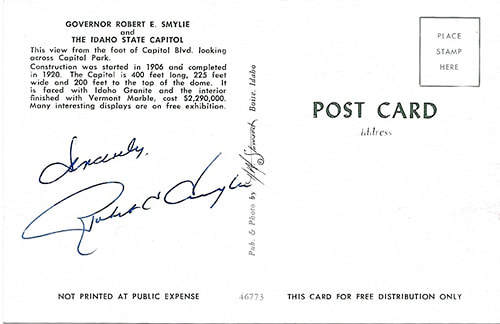 The address side of the card included a blurb about the statehouse, Governor Smylie’s signature, and a note that the postcards weren’t printed at public expense. I don’t know who paid for the printing.
The address side of the card included a blurb about the statehouse, Governor Smylie’s signature, and a note that the postcards weren’t printed at public expense. I don’t know who paid for the printing.
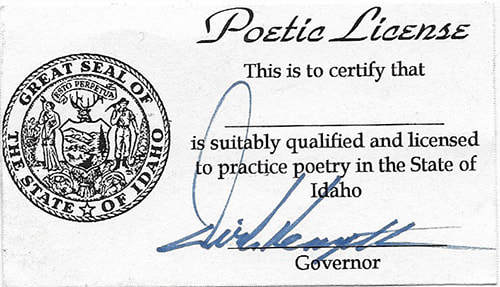 This final example is the size of a business card. It’s my favorite. I was going to spend the day at the Elk City elementary school teaching the students about poetry. It was something Tom Trusky had cooked up for a National Endowment for the Arts grant. I thought it would be fun to give the kids each a “poetic license” signed by the governor. Much of a governor’s correspondence is actually signed by a machine that does a beautiful job of replicating a signature. I had arranged ahead of time to have his staff run the 50 cards through the machine. When I got to the office, we found that the machine was out of order. I was headed for Elk City the next day. Since the machine was down, I’d have to just forget the idea.
This final example is the size of a business card. It’s my favorite. I was going to spend the day at the Elk City elementary school teaching the students about poetry. It was something Tom Trusky had cooked up for a National Endowment for the Arts grant. I thought it would be fun to give the kids each a “poetic license” signed by the governor. Much of a governor’s correspondence is actually signed by a machine that does a beautiful job of replicating a signature. I had arranged ahead of time to have his staff run the 50 cards through the machine. When I got to the office, we found that the machine was out of order. I was headed for Elk City the next day. Since the machine was down, I’d have to just forget the idea.
One of the governor’s aides excused himself for a moment. When he came back, he led me into the governor’s office. Dirk Kempthorne had agreed to sign each one individually while I waited. I was surprised that he took the time to do that for me and for the kids in Elk City.
There are collectors of gubernatorial signatures lurking around out there. I was one of them for a while. I collected a few from sitting governors when I came across them while working for the State of Idaho. Those were mostly proclamations and minor correspondence. Since I had a few of those, I decided to see if I could collect gubernatorial signatures from past governors.
It’s easy to start a hobby like that these days thanks to eBay. You can create a search bot that alerts you whenever the words governor, Idaho, and signature or autograph pop up. I collected a few signatures that were created during the course of business, such as a canceled check from George Shoup, Idaho’s last territorial governor and first state governor. Mostly, though, the signatures existed because someone wrote to the sitting governor and requested one.
Most governors answered requests like that by signing a blank card or even the outside of an envelope that was returned to the requestor. Here are a few samples.
 Governor Henry Clarence Baldridge simply signed the front of an official envelope.
Governor Henry Clarence Baldridge simply signed the front of an official envelope. Governor C.A. Robbins created a souvenir for those requesting his autograph. Above is a special reply in the shape of a potato with room for the signature on the back. On the inside there were three scenes of Idaho.
Governor C.A. Robbins created a souvenir for those requesting his autograph. Above is a special reply in the shape of a potato with room for the signature on the back. On the inside there were three scenes of Idaho. Governor Robert E. Smylie sent a postcard with his photo and a picture of the statehouse.
Governor Robert E. Smylie sent a postcard with his photo and a picture of the statehouse. The address side of the card included a blurb about the statehouse, Governor Smylie’s signature, and a note that the postcards weren’t printed at public expense. I don’t know who paid for the printing.
The address side of the card included a blurb about the statehouse, Governor Smylie’s signature, and a note that the postcards weren’t printed at public expense. I don’t know who paid for the printing. This final example is the size of a business card. It’s my favorite. I was going to spend the day at the Elk City elementary school teaching the students about poetry. It was something Tom Trusky had cooked up for a National Endowment for the Arts grant. I thought it would be fun to give the kids each a “poetic license” signed by the governor. Much of a governor’s correspondence is actually signed by a machine that does a beautiful job of replicating a signature. I had arranged ahead of time to have his staff run the 50 cards through the machine. When I got to the office, we found that the machine was out of order. I was headed for Elk City the next day. Since the machine was down, I’d have to just forget the idea.
This final example is the size of a business card. It’s my favorite. I was going to spend the day at the Elk City elementary school teaching the students about poetry. It was something Tom Trusky had cooked up for a National Endowment for the Arts grant. I thought it would be fun to give the kids each a “poetic license” signed by the governor. Much of a governor’s correspondence is actually signed by a machine that does a beautiful job of replicating a signature. I had arranged ahead of time to have his staff run the 50 cards through the machine. When I got to the office, we found that the machine was out of order. I was headed for Elk City the next day. Since the machine was down, I’d have to just forget the idea.One of the governor’s aides excused himself for a moment. When he came back, he led me into the governor’s office. Dirk Kempthorne had agreed to sign each one individually while I waited. I was surprised that he took the time to do that for me and for the kids in Elk City.
Published on May 23, 2024 04:00
May 22, 2024
First Day of Issue
Today, we have a couple of samples of First Day of Issue stamps and envelopes. The first one is from 1940, the 50th anniversary of Idaho statehood. The stamp depicts Idaho’s statehouse.
The second, from 50 years later, celebrates the state’s Centennial. Idaho’s state bird, the Mountain Bluebird is featured on the stamp.
This Bluebird cover was made unique by Mark D. Grabowski, an artist who specialized in painting little scenes on First Day of Issue envelopes. FYI, his envelopes sell for anywhere from $15 to $150 today, depending on rarity. I’m not sure what they sold for at the time of their creation.
According to our brainy friends at Wikipedia, “A first day of issue cover or first day cover (FDC) is a postage stamp on a cover, postal card or stamped envelope franked on the first day the issue is authorized for use[1] within the country or territory of the stamp-issuing authority. Sometimes the issue is made from a temporary or permanent foreign or overseas office. Covers that are postmarked at sea or their next port of call will carry a Paquebot postmark.[2] There will usually be a first day of issue postmark, frequently a pictorial cancellation, indicating the city and date where the item was first issued, and "first day of issue" is often used to refer to this postmark. Depending on the policy of the nation issuing the stamp, official first day postmarks may sometimes be applied to covers weeks or months after the date indicated.
Postal authorities may hold a first-day ceremony to generate publicity for the new issue. Postal officials may reveal the stamp, and connected persons, such as descendants of the person honored by the stamp, may attend. The ceremony may also be held in a location that has a special connection with the stamp's subject, such as the birthplace of a social movement or at a stamp show.
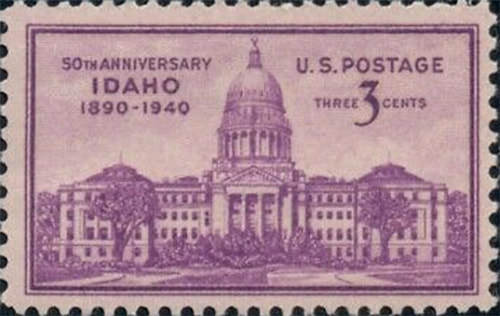
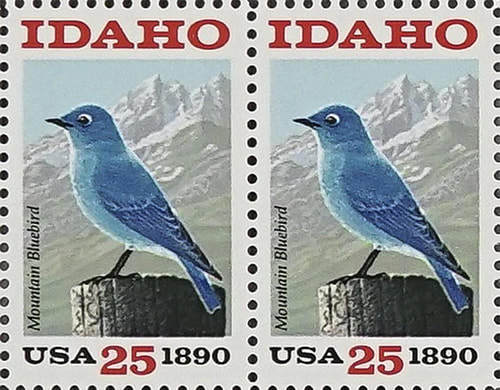
The second, from 50 years later, celebrates the state’s Centennial. Idaho’s state bird, the Mountain Bluebird is featured on the stamp.
This Bluebird cover was made unique by Mark D. Grabowski, an artist who specialized in painting little scenes on First Day of Issue envelopes. FYI, his envelopes sell for anywhere from $15 to $150 today, depending on rarity. I’m not sure what they sold for at the time of their creation.
According to our brainy friends at Wikipedia, “A first day of issue cover or first day cover (FDC) is a postage stamp on a cover, postal card or stamped envelope franked on the first day the issue is authorized for use[1] within the country or territory of the stamp-issuing authority. Sometimes the issue is made from a temporary or permanent foreign or overseas office. Covers that are postmarked at sea or their next port of call will carry a Paquebot postmark.[2] There will usually be a first day of issue postmark, frequently a pictorial cancellation, indicating the city and date where the item was first issued, and "first day of issue" is often used to refer to this postmark. Depending on the policy of the nation issuing the stamp, official first day postmarks may sometimes be applied to covers weeks or months after the date indicated.
Postal authorities may hold a first-day ceremony to generate publicity for the new issue. Postal officials may reveal the stamp, and connected persons, such as descendants of the person honored by the stamp, may attend. The ceremony may also be held in a location that has a special connection with the stamp's subject, such as the birthplace of a social movement or at a stamp show.


Published on May 22, 2024 04:00



